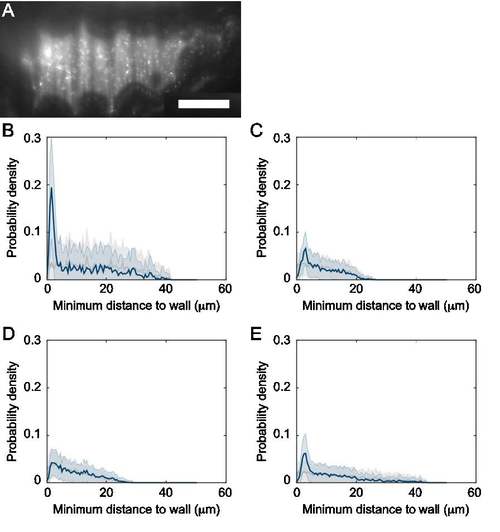- Title
-
Host Gut Motility Promotes Competitive Exclusion within a Model Intestinal Microbiota
- Authors
- Wiles, T.J., Jemielita, M., Baker, R.P., Schlomann, B.H., Logan, S.L., Ganz, J., Melancon, E., Eisen, J.S., Guillemin, K., Parthasarathy, R.
- Source
- Full text @ PLoS Biol.
|
Vibrio and Aeromonas have distinct community architectures and biogeographies within the larval zebrafish intestine. (A) A larval zebrafish at 5 dpf; the intestine is highlighted by phenol red dye via microgavage [27]. Scale bar: 500 μm. (B) A maximum intensity projection (MIP) of Vibrio in the larval intestine. Scale bar: 100 μm. (C) The probability density of Vibrio along the intestinal axis. From (B) and (C), we see that Vibrio is predominantly localized in the anterior bulb. (D) MIP of Aeromonas in the larval intestine. Scale bar: 100 μm. (E) The probability density of Aeromonas along the intestinal axis. (D) and (E) show that Aeromonas is predominantly localized in the midgut, with a smaller population in the anterior bulb. Underlying data for C and E are provided in S1 Data. |
|
Aeromonas experiences sharp drops in population size that are intensified during Vibrio challenge. (A) MIPs of Aeromonas (magenta) and Vibrio (cyan) in a larval zebrafish intestine. Scale bar: 200 μm. The fish was initially colonized at 4 dpf with Aeromonas, challenged 24 hr later by inoculation with Vibrio, and then imaged every 20 min for 14 hr. The times indicated denote hours post-challenge. In all images, the region shown spans about 80% of the intestine, with the anterior on the left. Image contrast in both color channels is enhanced for clarity. Yellow dotted line roughly indicates the lumenal boundary. As time progresses, the anterior growth of Vibrio as well as abrupt changes in the Aeromonas distribution (arrows) are evident. (B,C) Total bacterial abundance, derived from image data, for Aeromonas and Vibrio in two representative fish inoculated and challenged as in panel A, as a function of time following the Vibrio inoculation. Sharp drops of over an order of magnitude in the Aeromonas population, but not the Vibrio population, are evident. (D,E) Total abundance for Aeromonas in mono-associations as a function of time post-inoculation, in two representative fish. Sudden declines are also observed, though in general the populations recover to approximately pre-collapse levels. (F) The ratio, f, of the abundance immediately after to that before population drops, for Aeromonas challenged by Vibrio; this ratio spans many orders of magnitude (horizontal axis). At the same time points, the Vibrio populations are essentially unchanged, with ratios of populations afterward to before being close to one (vertical axis). (G) Characteristics of Aeromonas population collapses. Circles and bars indicate the mean and standard deviation, respectively, of f and pc, the magnitude and rate of collapse occurrence, for both mono-associations and Aeromonas challenged by Vibrio. The dashed line at f = 0.1 indicates the threshold for identification of collapses. Underlying data for B–G are provided in S1 Data. |
|
Populations of Vibrio and Aeromonas exhibit different dynamics within the zebrafish intestine. (A) An optical section of the intestinal bulb from a larval zebrafish mono-associated with Vibrio (the cyan box in the diagram below outlines the region imaged). The population consists of discrete, highly motile individuals (inset: single Vibrio cells). (B) A montage of images taken from the time-series in S3 Movie shows that the highly motile and planktonic Vibrio cells maintain their overall distribution despite repeated intestinal contractions. Time between frames: 1 second. (C) An optical section of the intestinal midgut from a larval zebrafish mono-associated with Aeromonas (the magenta box in the diagram below outlines the region imaged). Cells are largely non-motile and densely aggregated. (D) A montage of images taken from the time-series in S7 Movie shows an aggregate of Aeromonas in the midgut that is spatially dynamic, entering and exiting the field of view multiple times. Time between frames: 1 second. (A–D) Scale bars: 50 μm. |
|
Space-filling properties of Vibrio within the zebrafish gut. (A) Single optical plane of 6 dpf larval zebrafish inoculated at 4 dpf with GFP-labeled Vibrio. Scale bar: 50 μm. (B–E) Blue curves: Spatial distribution of bacteria with respect to the approximate extent of the intestinal epithelial wall. Gray curves: prediction from a null model of uniform space filling. Each panel represents an individual fish with panel B being from the same specimen in panel A. Underlying data are provided in S1 Data. |

